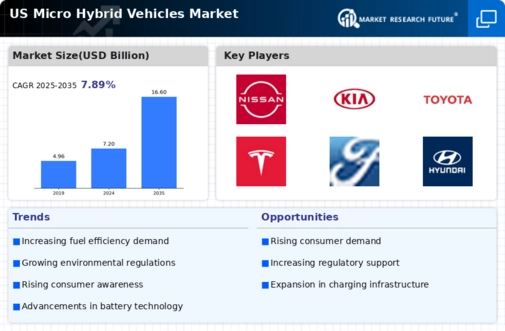The US Micro Hybrid Vehicles Market is characterized by an increasing consumer demand for fuel-efficient solutions and lower emissions due to tightening regulations and growing environmental awareness. The competitive landscape is influenced by a diverse range of automakers who are continuously innovating and adapting to consumer preferences. Key players are investing in advanced technologies designed to enhance vehicle efficiency, reduce fuel consumption, and improve overall performance. This market features a mix of established automotive giants and emerging players, each vying for market share while focusing on sustainability and affordability.
The rising trend in electrification and hybrid technology has prompted companies to develop more integrated micro hybrid systems that assist in enhancing fuel efficiency without compromising performance, making the market dynamic and rapidly evolving.Nissan has made significant strides in the US Micro Hybrid Vehicles Market by leveraging its reputation for innovation and sustainability. With a strong commitment to reducing carbon footprints, Nissan's micro hybrid models offer enhanced fuel efficiency while ensuring a smooth driving experience. The company emphasizes advanced technologies such as start-stop systems and regenerative braking, which contribute to lower emissions and cost savings for consumers.
Nissan’s strong market presence in the US is supported by a widespread dealership network and robust after-sales service.
The company capitalizes on its years of engineering excellence and brand loyalty among consumers seeking environmentally friendly options without sacrificing performance. By continuously refining its product offerings and investing in customer outreach, Nissan has positioned itself as a trusted name in the micro hybrid segment.Kia has established itself as a formidable player within the US Micro Hybrid Vehicles Market by offering a range of vehicles that combine efficiency with stylish design. Kia's micro hybrid models are equipped with advanced features that enhance fuel efficiency and reduce emissions.
The company's focus on value and quality has resonated well with consumers, leading to steady growth in market presence. Kia’s strengths include a diverse portfolio of vehicles, competitive pricing strategies, and a commitment to technology and innovation. The brand has engaged in strategic collaborations and investments to enhance its capabilities in hybrid technology. Furthermore, Kia has undertaken mergers and acquisitions to strengthen its market position and foster robust research and development initiatives focused on electric and hybrid vehicles.
These moves have underscored Kia’s intent to lead the charge in sustainable mobility solutions within the competitive micro hybrid landscape of the US.
























